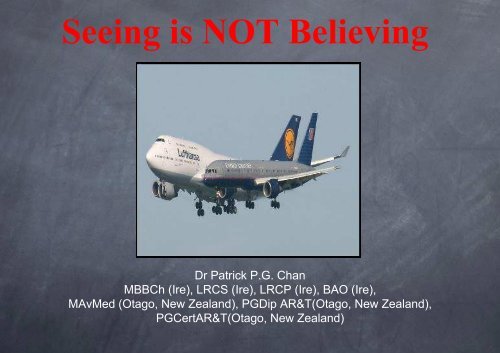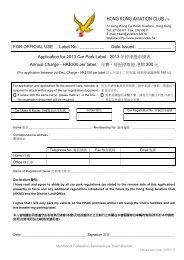Spatial Disorientation - Aviation Club
Spatial Disorientation - Aviation Club
Spatial Disorientation - Aviation Club
You also want an ePaper? Increase the reach of your titles
YUMPU automatically turns print PDFs into web optimized ePapers that Google loves.
Seeing is NOT Believing<br />
Dr Patrick P.G. Chan<br />
MBBCh (Ire), LRCS (Ire), LRCP (Ire), BAO (Ire),<br />
MAvMed (Otago, New Zealand), PGDip AR&T(Otago, New Zealand),<br />
PGCertAR&T(Otago, New Zealand)
Gulf Air Flight 072<br />
• 23 rd August, 2000<br />
• Cairo – Bahrain A320<br />
• Crashed, 143 killed<br />
• 1930 hrs local time
Gulf Air Flight 072<br />
• Auto-pilot off<br />
• VOR/DME approach<br />
• Too high & too fast at 0.9<br />
Nm from runway 12<br />
• Approach aborted
Gulf Air Flight 072<br />
• 250 kts below 10000 ft as per<br />
flight manual<br />
• 330 kts, at 2300 feet<br />
• Did not execute missed<br />
approach<br />
• 360° left, 500 – 600 ft<br />
attempt to land again
Gulf Air Flight 072<br />
• Non standard, involving<br />
considerable variations<br />
• Re-intercept with approach<br />
• Overshot runway
Gulf Air Flight 072<br />
• Ignored GPWS warnings<br />
• Misperception of pitch, multiple cockpit<br />
distractions<br />
• <strong>Spatial</strong> disorientation
<strong>Spatial</strong> <strong>Disorientation</strong><br />
• Getting lost not covered by this definition<br />
• Pilot confusion about position, attitude & motion of<br />
aircraft<br />
• Rapidly changing, dynamic flight environment<br />
• Degree of freedom, no direct link with Earth
<strong>Spatial</strong> Orientation<br />
• Natural ability to maintain our body orientation ±<br />
posture in relation to the surrounding environment<br />
at rest & during motion
<strong>Spatial</strong> Orientation<br />
• Designed to maintain spatial orientation on the<br />
ground<br />
• Hostile flight environment creates conflict &<br />
illusions<br />
• 5 – 10% GA accidents due to disorientation<br />
• 90% FATAL
<strong>Spatial</strong> Orientation<br />
• Ground<br />
• Visual, vestibular,<br />
proprioceptive inputs<br />
• Acceleration & gravity<br />
changes<br />
• Compared with visual<br />
information
<strong>Spatial</strong> Orientation<br />
• Flight<br />
• Brain – key organ<br />
• Attitude, position & motion
<strong>Spatial</strong> Orientation #1<br />
• Motion – directional<br />
• Linear, rotational or combination<br />
• No value w/o specific data on direction vector
<strong>Spatial</strong> Orientation #2<br />
• Information judged according to point of reference<br />
• Intersection of Earth’s surface & vertical vector of<br />
gravitational pull<br />
• Earth is left behind in flight<br />
• Gravitational vector may be modified<br />
• Brain continues to interpret body position changes
<strong>Spatial</strong> Orientation #3<br />
• Reference point may change<br />
• Aerial combat or formation flying<br />
• Cloud top, moon, sun<br />
• If you fly helicopter, beware of cables!
<strong>Spatial</strong> Orientation #4<br />
• Extrapolates what he feels to what he perceives the<br />
aircraft to be doing<br />
• Strong<br />
• Extreme freedom in flight, attitude potentially free<br />
to vary<br />
• Confusion, nausea & stress
<strong>Spatial</strong> <strong>Disorientation</strong><br />
• Loss of situational awareness<br />
• Type I : unrecognized – greater flight hazard<br />
• Type II : recognized – discrepancy between pilot &<br />
aircraft
<strong>Spatial</strong> <strong>Disorientation</strong><br />
• Pilot preoccupation or distraction<br />
• Failure to respond to warning devices<br />
• Over-reliance on automated systems<br />
• Interpretation errors<br />
• CRM failures
“Coning of Attention”<br />
rn Airlines 401 L-1011 (1972).<br />
ight crew became pre-occupied<br />
faulty landing wheel light<br />
tor and accidentally turned off<br />
topilot set for 2000 feet. The<br />
realised their error too late and<br />
too low to recover, impacting<br />
orida Everglades
Vestibular Physiology<br />
• Inner ear<br />
• Organ of equilibrium<br />
• Semicircular canals : angular<br />
acceleration<br />
• Otolith organs : linear<br />
acceleration & gravity
Vestibular Physiology<br />
• 3 circular canals<br />
• Connected at right angles to<br />
one another
Vestibular Physiology<br />
• Corresponds to pitching,<br />
rolling & yawing
Vestibular Physiology
Vestibular Physiology
Vestibular Illusions<br />
• Somatogyral illusions<br />
• Leans<br />
• Graveyard spin<br />
• Graveyard spiral<br />
• Coriolis illusion
The “Leans”<br />
• Most common, clearly<br />
identifiable, single<br />
• Type II<br />
• Nuisance<br />
• Sudden return to level flight,<br />
following gradual prolonged<br />
turn
The “Graveyard Spin”<br />
• Intentional or unintentional<br />
spin<br />
• Idle throttle, ailerons neutral<br />
• Apply & hold rudder in<br />
opposite direction<br />
• Break stall<br />
• Hold & wait until rotation<br />
stops
The “Graveyard Spiral”<br />
• More common<br />
• Return to level flight<br />
following intentional or<br />
prolonged bank turn
The “Coriolis Illusion”<br />
• Stimulation of 2 semicircular<br />
canals<br />
• Sudden tilting of pilot’s head<br />
when aircraft is turning<br />
• Pitching, rolling & yawing at<br />
the same time
The Otoliths<br />
• Saccule & utricle<br />
• Right angle to each other<br />
• Utricle : linear acceleration<br />
in horizontal<br />
• Saccule : gravity changes in<br />
vertical plane
The Otoliths<br />
• Located at base of<br />
semicircular canals<br />
• Contain small sacs covered<br />
by hair filaments<br />
• Project into gelatinous<br />
membrane
The Otoliths<br />
• Weight of organs pulls<br />
cupula (gelatinous<br />
membrane)<br />
• Hair cells bent<br />
• Signals sent to brain e.g.<br />
vertical take-off in helicopter
The Otoliths<br />
• Forward linear acceleration<br />
produces backward<br />
movement<br />
• Hair cells bent<br />
• Signals sent to brain<br />
• Forward movement
The Otoliths
Vestibular Illusions<br />
• Somatogravic illusions<br />
• Unreliable or unavailable external visual cues<br />
• “Inversion” illusion<br />
• “Head-up” illusion<br />
• “Head-down” illusion
The “Inversion Illusion”<br />
• Steep ascent then sudden<br />
level flight<br />
• Relative high speed after<br />
leveling off<br />
• False sensation of inverted
The “Head-up Illusion”<br />
• Sudden forward linear<br />
motion following level flight<br />
• Pitch up<br />
• Push yolk or stick forward<br />
• Night or catapult T/O
The “Head-down Illusion”<br />
• Sudden linear deceleration<br />
following level flight<br />
• Pitch down<br />
• Will stall aircraft if try to<br />
correct
Prevention<br />
• <strong>Spatial</strong> disorientation training<br />
• Before flying < 3 miles visibility, training &<br />
proficiency in aircraft control w/ reference to<br />
instruments<br />
• Maintain night flying currency<br />
• If only VFR qualified, DO NOT t/o in deteriorating<br />
weather
Gulf Air Flight 072<br />
• Somatogravic illusion in total darkness<br />
• False sense of pitching up<br />
• Pilot responded<br />
• Aircraft flew into sea at 280 kts & 6.5° nose down
Central & Visual Forms of<br />
<strong>Disorientation</strong>
Ryanair Flight 9884<br />
• 29 th March 2006<br />
• Liverpool to City of Derry<br />
• Maiden City<br />
• Balleykelly Camp<br />
• Army airfield 5 miles away
Ryanair Flight 9884<br />
• Cleared to land by ATC on VFR to Derry<br />
• Mistook airfield
Ryanair Flight 9884<br />
• Steps brought by road for passengers to disembark<br />
• Greeted by soldiers with a laugh!
Vision & <strong>Spatial</strong><br />
Orientation<br />
• Visual cues<br />
• Important information<br />
• Maintain spatial orientation in flight & on ground<br />
• Especially when in motion<br />
• Birds cannot fly safely w/o visual reference
Vision & <strong>Spatial</strong><br />
Orientation<br />
• Central or foveal<br />
• Peripheral
Central Vision<br />
• Identification of objects<br />
• Colour perception<br />
• Allows pilots to gather info from instruments<br />
during IFR<br />
• Allows pilots to acquire external info to judge<br />
distance, speed & depth during VFR
Peripheral Vision<br />
• Ambient vision<br />
• Perception of movement<br />
• Walk & read at the same time!<br />
• Surrounding environment motion can produce self<br />
motion
Central Forms of<br />
<strong>Disorientation</strong><br />
• Coning of attention, task saturation, stress reactions<br />
• Giant hand illusion<br />
• Negative transfer<br />
• Temporal disorientation<br />
• Break-off
Giant Hand Illusion<br />
• Loss of aircraft control to an<br />
external force pulling on<br />
control column<br />
• Mechanical failure assumed<br />
• Anxiety or over-arousal<br />
• Period of distraction<br />
• Hands occupied
Giant Hand Illusion<br />
• Prior misconception of aircraft attitude<br />
• Change of gravity vector<br />
• Involuntary & unconscious<br />
• Pilot thinks he is pulling back, but really is pushing<br />
forward
Negative Transfer Illusion<br />
• When “feel” of aircraft’s controls or instrument<br />
display<br />
• Differs from what pilot is used to
Negative Transfer Illusion<br />
• Aircraft type conversion e.g. trainer to strike<br />
• Changing type & role e.g. fixed wing to rotary<br />
wing<br />
• Expect trouble if instrument displays are different
Temporal <strong>Disorientation</strong><br />
• Occurs in periods of intense stress<br />
• Temporary slowing of perceived passage of time<br />
• Leads to loss of situational awareness<br />
• To eject or not to eject, that is the question
Temporal <strong>Disorientation</strong><br />
• Brain unable to accept rapid development of events<br />
• Forced to interpret huge amount in a short period as<br />
lengthening of time<br />
• Distortion greatest when perceived dangers are<br />
more serious or recognized late
Break-Off<br />
• Unusual perception of depersonalization<br />
• Sensory input reduced by high altitude<br />
• Reduced sensory input or deprivation<br />
• Student pilot 1 st solo.
Visual Illusions in Flight<br />
• 10 11 12 13 14<br />
• E D C 13 A
Visual Illusions in Flight<br />
• Pilot’s visual reference to natural horizon<br />
• When obscured, can be maintained by surface<br />
below<br />
• When both obscured, maintained by artificial<br />
means viz. instruments<br />
• Smoke, fog, smog, haze, etc
Visual Illusions in Flight<br />
• Normal approach
Visual Illusions in Flight<br />
• Up-sloping runway on FLAT terrain<br />
• High approach
Visual Illusions in Flight<br />
• Down-sloping runway on FLAT terrain<br />
• Low approach
Visual Illusions in Flight<br />
• Flat runway on UPSLOPING terrain<br />
• Low approach
Visual Illusions in Flight<br />
• Flat runway on DOWNSLOPING terrain<br />
• High approach
Visual Illusions in Flight<br />
• Unusually long or narrow runway<br />
• High approach
Visual Illusions in Flight<br />
• Unusually wide<br />
• Low approach
Visual Illusions in Flight<br />
• “Black hole” approach<br />
• No stars or moonlight over<br />
water<br />
• Unlit terrain to lit runway<br />
• No peripheral vision<br />
• Runway tilted left & upsloping
Visual Illusions in Flight<br />
• Visible horizon<br />
• Easily orient w/ central<br />
vision
• High approach<br />
Visual Illusions in Flight<br />
• Hazardous “black hole”<br />
• No lights before runway<br />
• City lights or rising terrain beyond runway
Visual Illusions in Flight<br />
• Autokinetic illusion<br />
• Stationary object moving in<br />
plane’s path<br />
• Staring a fixed point of light<br />
in totally dark & featureless<br />
background<br />
• Light on collision course
Summary<br />
No pilot can fly in IFR conditions without instruments<br />
The inner ear can give false positional information unles<br />
there is also a visual reference.<br />
You can literally fly upside down and not know it<br />
You can lose orientation in less than 20 seconds if you<br />
are in clouds and are not on instruments!
Take off is VOLUNTARY……<br />
BUT<br />
Landing is MANDATORY




